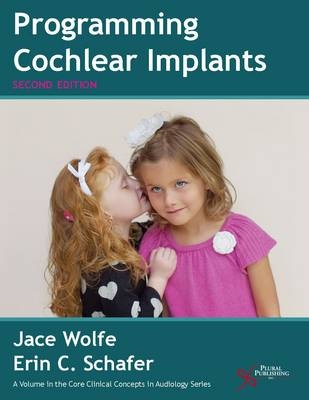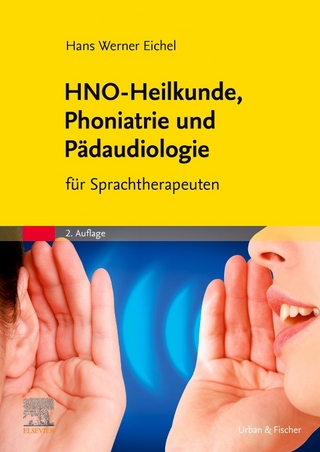
Programming Cochlear Implants
Plural Publishing Inc (Verlag)
978-1-59756-552-3 (ISBN)
- Titel ist leider vergriffen;
keine Neuauflage - Artikel merken
Cochlear implants offer significant benefits for children and adults with severe to profound hearing loss; however, to realize these benefits the device must be carefully and correctly programmed. With current information on cochlear implant technology, Programming Cochlear Implants, Second Edition - a volume in the Core Clinical Concepts in Audiology Series - is a valuable guide for clinicians providing services to cochlear implant users or as a teaching tool for graduate-level students. Programming Cochlear Implants, Second Edition introduces the basics of cochlear implant hardware and programming and continues through advanced programming techniques, with manufacturer-specific information and case studies.The text reviews clinical protocols for cochlear implant management; programming considerations for bilateral cochlear implant; troubleshooting during the programming process; device-specific programming techniques; use of objective measures to set cochlear implant programs; use of FM and assistive listening devices with cochlear implants; and providing support to difficult-to-program users, such as infants, cognitively-impaired individuals, persons with disabilities, and so forth.
New topics addressed in the second edition include: Preservation of residual hearing following cochlear implant surgery Programming cochlear implants for patients with substantial residual hearing in the low-frequency range, including electrode array options Cochlear implant impedances and the impact of impedance on programming and management Signal coding strategies and signal processing Theoretical concepts that may influence cochlear implant programming
Jace Wolfe, PhD, is the Director of Audiology at the Hearts for Hearing Foundation. He also is an adjunct Assistant Professor in the Audiology Department at the University of Oklahoma Health Sciences Center. He serves as the editor for the American Speech Language Hearing Association's Division 9 journal. His areas of interests are pediatric cochlear implantation, personal FM systems, and signal processing for children. He provides clinical services for children and adults with hearing loss and is also actively engaged in research in several areas pertaining to cochlear implants and personal FM systems. Erin C. Schafer, PhD is an Assistant Professor in the Department of Speech and Hearing Sciences at the University of North Texas, where she has held an academic appointment since August 2005. She teaches graduate courses in the areas of aural rehabilitation, pediatric habilitation, diagnostic audiology, and research methods, and she serves as an Educational Audiology consultant for local school districts. Her current research focuses on strategies to enhance communication abilities of children and adults who have hearing loss, hearing aids, and cochlear implants. Dr. Schafer received her B.S. degree in Communication Sciences from Texas Woman's University, and her M.S. and Ph.D. degrees in Audiology from The University of Texas at Dallas. She is active in professional organizations, serves as an Associate Editor for the Journal of Educational Audiology, and is past president of the Scott Haug Audiology Foundation.
Foreword Preface Acknowledgments Basic Components and Operation of a Cochlear Implant Basic Operation of Cochlear Implants Basic Components of Current Cochlear Implant Systems Advanced Bionics Corporation Sound Processors Internal Devices Cochlear Limited Sound Processors Internal Devices MED-EL Corporation Sound Processors Internal Devices Key Concepts Basic Terminology of Cochlear Implant Programming Parameters Affecting Signal Coding in the Intensity Domain Stimulation Levels Threshold of Stimulation Upper Stimulation Levels Current Amplitude and Pulse Width Mapping Acoustical Inputs into the Electrical Dynamic Range Input Dynamic Range (IDR) Sensitivity Compression Channel Gain Volume Control Parameters Affecting Signal Coding in the Frequency Domain Electrode Contact versus Channel Virtual Electrodes (Current Steering) Frequency Allocation Parameters Affecting Signal Coding in the Time Domain Stimulation Rate Basic Cochlear Implant Terminology Electrode Coupling Strategy/Stimulation Mode Sequential versus Simultaneous Stimulation Interpolation Sweeping Loudness Balancing Radio Frequency (RF) Telemetry Electrode Impedance Voltage Compliance Mixing Ratio Basic Cochlear Implant Signal Coding Strategies Continuous Interleaved Sampling (CIS) HiResolution Sound Processing HiResolution Fidelity 120 HiRes Optima n-of-m Strategies Spectral Peak (SPEAK) Advanced Combination Encoder (ACE) Fine Structure Processing (FSP) Simultaneous Analog Stimulation (SAS) Key Concepts Basic Principles of Programming Pre-Activation Procedures Realistic Expectations Prior to Activation Reviewing Logistics of Cochlear Implantation Familiarity with Cochlear Implant Hardware Setting the Stage Programming After Implantation Physical Evaluation Selecting a Signal Coding Strategy Streamlined versus Comprehensive Programming Measuring Stimulation Levels Setting Threshold Levels for Adults Setting Threshold Levels for Children Additional Measure to Ensure Adequate T Levels and Confirm Audibility Setting Upper Stimulation Levels for Adults Setting Upper Stimulation Levels for Children Additional Measures to Set Stimulation Levels Adjustments to Special Parameters Stimulation Rate Pulse Width Channel Gain Frequency Allocation Input Dynamic Range (IDR) Maxima Key Concepts Manufacturer-Specific Programming Considerations Advanced Bionics Corporation HiResolution (HiRes) 90K Advantage System Electrode Impedance Selecting a Signal Coding Strategy Setting Stimulation Levels Additional Programming Parameters Programming Previous Generations of Advanced Bionics Implants Cochlear Limited The Nucleus 6 System Electrode Impedance Selecting a Signal Coding Strategy and Preprocessing Parameters Setting Stimulation Levels Additional Programming Parameters Programming Previous Generations of Nucleus Implants MED-EL Corporation Programming MED-EL Recipients in Fine Structure Processing Electrode Impedance Selecting a Signal Coding Strategy Setting Stimulation Levels Additional Programming Parameters Programming Previous Generations of MED-EL Implants Key Concepts Clinical Considerations: Putting All of the Pieces Together Collaboration with the Cochlear Implant Surgeon/Medical Evaluation Programming Schedule Two-Day Initial Activation Sessions One-Week Postactivation Appointment One-Month Postactivation Programming Session Remainder of Programming Schedule The Role of Objective Measures in Programming Additional Habilitative/Rehabilitative Considerations Special Tips for Facilitating Cooperation of Children Considerations for Bilateral Cochlear Implantation Key Concepts Troubleshooting Patient Complaints and Complications Managing Recipients Who Experience Disappointing Outcomes External Hardware Determine Wear Schedule and Facilitate an Auditory Lifestyle Evaluate the Appropriateness of the Cochlear Implant Program Assessment of Internal Hardware Identifying "Red Flags" Factors Influencing Cochlear Implant Outcomes Additional Disabilities Bacterial Meningitis Aplastic Auditory Nerves Inner Ear Malformations Prelingual Deafness and Duration of Deafness Prior to Implantation Advanced Age Internal Device Function Programming Adjustments for the Most Common Complaints and Complications Key Concepts Hearing Assistance Technology (HAT) and Cochlear Implants Basic Description of Personal Systems Optimal Systems for Use with a Cochlear Implant Description and Programming for Personal HAT and Cochlear Implants FM Transmitters RF, FM, and Induction Loop Receivers Programming Considerations for RF/FM Receivers and Sound Processors Programming Digital RF or FM Receivers Sound Processor Programming and HAT Fitting Procedures for Personal RF/FM Systems Monitoring and Troubleshooting Personal RF/FM Systems for Cochlear Implants HAT to Improve Telephone Conversations Telecoils Telecoil Accessories Streaming Devices Summary of HAT for Cochlear Implants Key Concepts Electroacoustic Programming Introduction Theoretical Benefits Literature Review Hardware Considerations Post-operative Assessment Programming Protocol Fitting the Acoustic Component Basic Management Considerations Case Studies References Index
| Erscheint lt. Verlag | 1.3.2015 |
|---|---|
| Zusatzinfo | 2/C |
| Verlagsort | San Diego |
| Sprache | englisch |
| Maße | 216 x 279 mm |
| Gewicht | 953 g |
| Themenwelt | Medizin / Pharmazie ► Gesundheitsfachberufe ► Logopädie |
| Medizin / Pharmazie ► Medizinische Fachgebiete ► HNO-Heilkunde | |
| ISBN-10 | 1-59756-552-0 / 1597565520 |
| ISBN-13 | 978-1-59756-552-3 / 9781597565523 |
| Zustand | Neuware |
| Haben Sie eine Frage zum Produkt? |
aus dem Bereich


